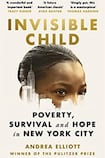
In 2013, Andrea Elliott published a five-part story in the New York Times about an 11-year-old girl named Dasani Coates who was living with her seven siblings, her mother and her stepfather in one freezing, mouldy, rodent-infested room in a Brooklyn shelter. The story caused a public outcry and many political pledges were made to end child poverty. Dasani found herself celebrated and on a stage with the new mayor of New York, Bill de Blasio, at his inauguration.
If you engage in the sort of magical thinking that tells you talented people can transcend circumstance, this would be the end of the story. But as Elliott writes: “Whatever power came from being in The Times was no match for the power of poverty in Dasani’s life.”
Elliott spent the next eight years following Dasani and her family and has roduced a substantial book about them. Invisible Child: Poverty, Survival and Hope in an American City is a visceral, moving and shocking depiction of how poverty and the social infrastructure of poverty degrades, oppresses and punishes the vulnerable.
The style is novelistic, with Elliott frequently adopting the close third person perspective of Dasani; her mother, Chanel; her stepfather, Supreme; or her siblings, teachers or counsellors. It often feels like an epic family saga but while the book does sometimes evoke Dickens or Steinbeck, it comes with 150 pages of notes at the end, sourcing everything that Elliott describes.
The story Elliott tells happens against a backdrop of New York's wealth and plenty. Dasani's hunger pangs occur next to large-windowed apartments with heated floors
She has done meticulous work. Each member of Dasani’s family emerges as a complex, compelling person at the whims of an inhumane, inconsistent and chaotic welfare system. Dasani is nurturing, determined, thoughtful and voluble. Chanel and Supreme have issues with addiction and engage in petty crime (usually to provide for the family), but they love their children and are fiercely protective of them against horrible odds. One of their daughters is going blind. Other children have developmental issues directly related to the poverty they were born into.
Elliott also explores the lives of Dasani’s key workers and schoolteachers, some of whom have also experienced poverty and racism (one of Dasani’s kindest teachers ends up moving into a shelter over the course of the book).
Elliott presents poverty as cross-generational and structural. She delves into Chanel and Supreme’s troubled family histories and contextualises them within a wider history of institutional racism in the United States, from Jim Crow to the crack epidemic to the increasing criminalisation of the poor and black. The story she tells happens against a backdrop of New York’s wealth and plenty. Dasani’s hunger pangs occur next to large-windowed apartments with heated floors.
Eventually, Dasani gets a scholarship to the Milton Hershey School, a philanthropic boarding school designed to help disadvantaged children. Again, if you’re looking for a meritocratic narrative about how good people flourish against the odds, this is where you might end the story. But despite all the opportunities the school offers Dasani, she struggles with loneliness and has a crisis of identity about the “code switching” that middle-class aspirations require.
Elliott wonders why some of that money couldn't be spent to help keep families together and out of poverty
The survival mechanisms she learned in the shelter and in the public schooling system – her desire to look after her siblings (she calls them “my kids”) and her willingness to physically fight those who threaten her family – stop her from thriving in a place where she’s expected to focus on her own development and rely on calmer forms of conflict resolution. Elliott backs her observations here with research data on the physiological and psychological consequences of trauma and stress. Vast inequality isn’t just impoverishing people, it’s damaging them.
Meanwhile, Dasani’s family struggles. Chanel fails to take a court-mandated drugs test and is forbidden to see her children. She ends up on the streets. Now living in a dilapidated flat co-owned by a private debt billionaire, Supreme finds himself in a Kafkaesque situation. No one has transferred Chanel’s family food stamps into his name and his children are hungry. It’s at this point that the agencies tasked to help the family seem most farcically cruel and punitive, with caseworkers judgmentally noting the lack of food in their notebooks while offering little practical help (at one point, they give Supreme a list of food pantries that are all too far to travel to).
The authorities ultimately determine that the chaos Supreme and his family are living in is a product of personal failure rather than systemic poverty, and Dasani’s siblings are separated and put into foster care.
Once more, Elliott notes a structural issue with disturbing historical resonances. Family separation is disproportionately visited on black families by US authorities, and many of these children do not fare better in the costly care system. Elliott wonders why some of that money couldn’t be spent instead to help keep families together and out of poverty.
Over the period Elliott was writing this book, racism was again at the forefront of American discourse. Donald Trump, who openly courted white supremacists, was elected president and George Floyd’s death gave rise to the Black Lives Matter movement. The ferment is ongoing.
Invisible Child doesn’t really end either. It just pulls away. Dasani and her family are still in New York, still separated and still experiencing poverty, and the social forces that hurt them are still in place.
This is an eye-opening, heartbreaking and deeply enraging book about the realities of contemporary US inequality. Thanks to Elliott, and the openness of Dasani and her family, nobody can say they weren’t told.









